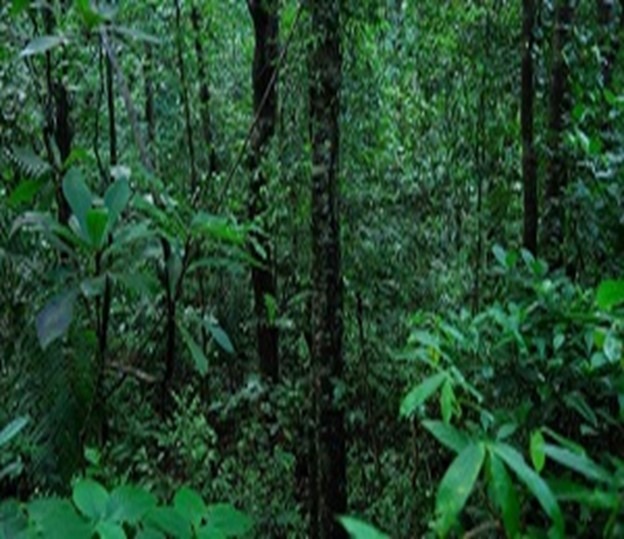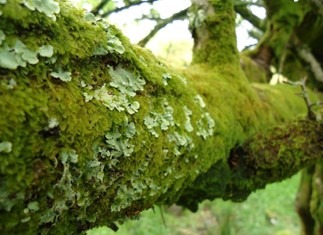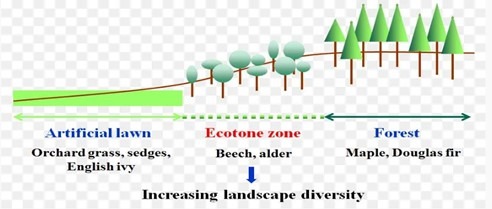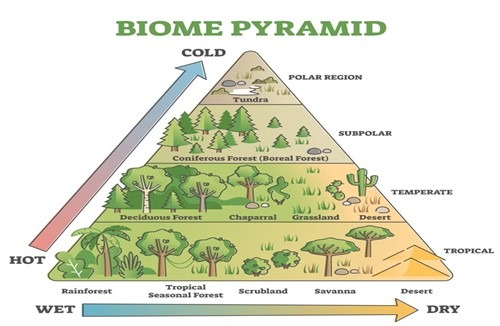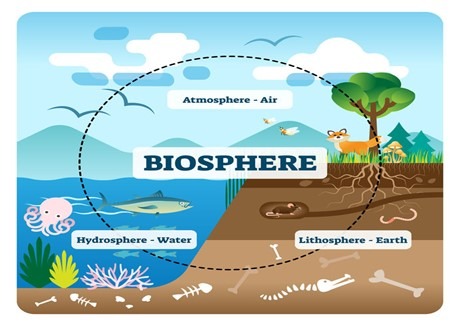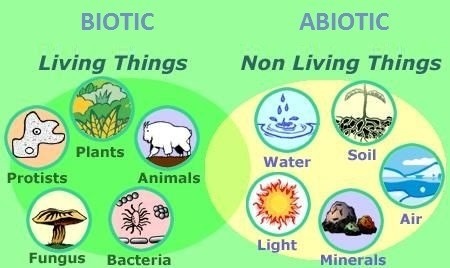Environment, Habitate and ecosystem
Environment:
The interaction between biotic (living) and abiotic (non-living) factors is a fundamental aspect of ecosystems, shaping the habitat, distribution, and survival of organisms. These interactions influence species behavior, population dynamics, and the overall structure of ecosystems. Understanding these relationships is crucial for conservation, ecological balance, and sustainable resource management.
Biotic and Abiotic Factors: Defining Ecosystems
Ecosystems consist of two main components:
1. Biotic Factors (Living Components):
- Organisms that interact with each other within an ecosystem.
- Examples:
- Producers (Plants & Algae): Convert sunlight into energy via photosynthesis.
- Consumers (Herbivores, Carnivores, Omnivores): Depend on other organisms for food.
- Decomposers (Bacteria & Fungi): Break down dead matter, recycling nutrients into the environment.
2. Abiotic Factors (Non-Living Components):
- Environmental conditions that impact living organisms.
- Examples:
- Climate: Temperature, humidity, and precipitation influence species distribution.
- Soil Composition: Determines plant growth and nutrient availability.
- Water Availability: Essential for survival; freshwater vs. marine ecosystems differ.
- Sunlight: Affects photosynthesis and energy flow in ecosystems.
- Air and Atmospheric Gases: Oxygen and carbon dioxide regulate respiration and photosynthesis.
The interaction between these factors defines an organism’s habitat (where it lives) and its ecological niche (its role in the ecosystem).
How Biotic and Abiotic Factors Shape Habitats and Ecosystems
1. Influence on Species Distribution and Adaptation
- Different species adapt to specific abiotic conditions, leading to diverse ecosystems.
- Example:
- Cacti thrive in deserts due to their ability to store water and reduce transpiration.
- Polar bears in the Arctic have thick fur and fat layers for insulation against freezing temperatures.
2. Food Chains and Energy Flow
- Sunlight (Abiotic) → Plants (Biotic) → Herbivores → Carnivores → Decomposers
- The energy pyramid shows how energy flows from one trophic level to another, with producers forming the base.
3. Impact of Climate and Weather Patterns
- Climate change alters ecosystems, forcing species to migrate, adapt, or face extinction.
- Example:
- Coral bleaching in oceans due to rising temperatures affects marine biodiversity.
- Forest ecosystems shift as tree species struggle to survive in warming conditions.
4. Role in Ecological Succession
- Over time, ecosystems change due to interactions between biotic and abiotic components.
- Example:
- Primary succession: Formation of a new ecosystem on barren land (volcanic islands).
- Secondary succession: Regrowth of forests after wildfires.
5. Human Impact on Biotic-Abiotic Interactions
- Deforestation, pollution, climate change, and habitat destruction disrupt natural interactions.
- Conservation efforts focus on restoring balance, such as reforestation and protecting endangered species.
The delicate balance between biotic and abiotic factors determines the structure and function of ecosystems. These interactions influence the survival, reproduction, and adaptation of organisms, shaping the planet’s biodiversity. As human activities increasingly alter natural environments, understanding and preserving these relationships is essential for the sustainability of life on Earth.
Ecology:
Ecology, derived from the Greek words ‘oikos’ (meaning home or habitat) and ‘logos’ (meaning study), is the scientific discipline that examines the interactions between living organisms and their environment. This field investigates the relationships among organisms and how they are influenced by both biotic (living) and abiotic (non-living) factors.
Ecology is crucial for understanding the natural world, preserving biodiversity, managing natural resources, and addressing environmental challenges like climate change, habitat destruction, and pollution.
History of Ecology
The origins of ecological thought can be traced back to ancient civilizations that observed and documented the interdependence of organisms and their surroundings.
- In India, early medical treatises such as the Charaka-Samhita (an ancient text on medicine) and the Sushruta-Samhita (a surgical treatise) discussed the influence of environmental factors on human health, emphasizing the interconnection between living beings and their habitat.
- Classical Greek scholars like Aristotle and Theophrastus studied animal behavior and plant ecology, laying the foundation for modern ecological principles.
- During the 19th and 20th centuries, ecology developed as a distinct scientific discipline, with figures like Charles Darwin, Ernst Haeckel, and Arthur Tansley contributing to the understanding of ecosystems, evolution, and energy flow in nature.
Environment and Its Components
The environment is the sum of all external conditions, both biotic (living) and abiotic (non-living), that influence the existence, survival, and evolution of an organism. These components interact in complex ways to shape ecosystems and ecological relationships.
1. Biotic Components (Living Elements of the Environment)
Biotic components include all living organisms that influence and interact within an ecosystem. These are categorized as follows:
- Producers (Autotrophs): Green plants, algae, and certain bacteria that produce their own food through photosynthesis or chemosynthesis.
- Consumers (Heterotrophs): Organisms that depend on others for food, including herbivores (plant-eaters), carnivores (meat-eaters), omnivores (both plant and animal eaters), and decomposers.
- Decomposers: Fungi, bacteria, and other microorganisms that break down dead organic matter, recycling nutrients back into the ecosystem.
- Symbiotic Organisms: Parasites, mutualists, and commensals that rely on interactions with other organisms for survival.
- Humans: As a dominant species, human activities significantly impact ecosystems through urbanization, deforestation, pollution, and conservation efforts.
2. Abiotic Components (Non-Living Environmental Factors)
Abiotic factors shape ecosystems by influencing the survival and distribution of organisms. These include:
- Energy: Solar energy is the primary source of energy for life, driving photosynthesis and regulating climate.
- Radiation: Ultraviolet radiation affects plant growth and microbial life.
- Temperature & Heat Transfer: Governs species distribution, with different organisms adapting to various temperature ranges.
- Water: Essential for life, influencing hydration, photosynthesis, and metabolic processes in organisms.
- Atmospheric Gases: Oxygen for respiration, carbon dioxide for photosynthesis, and nitrogen for nutrient cycling.
- Wind: Affects weather patterns, seed dispersal, and temperature regulation in ecosystems.
- Fire: Natural wildfires play a role in ecosystem regeneration by clearing old vegetation and enriching the soil.
- Gravity: Determines the movement of water and sediments, influencing landscapes and species adaptation.
- Topography & Geology: Mountains, valleys, and soil composition affect species distribution and ecosystem productivity.
Levels of Organization in Ecology
Ecological study is organized into six primary levels, each representing a different scale of interaction between organisms and their environment.
1. Individual (Organism Level)
- A single living organism that can function independently, including plants, animals, fungi, bacteria, and protists.
- Each organism interacts with its surroundings to obtain food, reproduce, and survive.
2. Population (Group of the Same Species)
- A population consists of individuals of the same species inhabiting a specific geographic area at a given time.
- Population Growth Rate: Measures the percentage increase or decrease in population over time.
- Population Density: The number of individuals in a given area, influenced by birth rates, death rates, migration, and environmental conditions.
3. Community (Interaction Among Multiple Species)
- A community includes all the biotic components of an ecosystem.
- It consists of multiple species living and interacting within a defined space, such as forests, coral reefs, and freshwater lakes.
Types of Communities
Communities vary in size, structure, and independence. Based on these factors, communities are classified as:
1. Major Community:
- Large, self-sustaining, and relatively independent ecosystems that rely solely on solar energy for survival.
- Examples: Tropical rainforests, deserts, grasslands, and coral reefs.
2. Minor Community (Societies):
- Smaller, dependent on larger ecosystems for survival.
- They rely on neighboring communities for energy and nutrients.
- Example: Lichen growing on a rock or cow dung, dependent on external organic matter.
4. Ecosystem (Biotic & Abiotic Interactions)
- An ecosystem is a self-sustaining system that includes both biotic (living) and abiotic (non-living) factors interacting to support life.
- Ecosystems range from small (ponds) to large (oceans, rainforests).
5. Biome (Large-Scale Ecosystems)
- A biome is a collection of ecosystems sharing similar climatic conditions, vegetation, and wildlife.
- Examples include tropical rainforests, tundras, grasslands, and deserts.
6. Biosphere (The Global Ecological System)
- The biosphere is the sum of all ecosystems on Earth, including all life forms and their interactions with land, water, and atmosphere.
- It is the most extensive level of ecological organization, encompassing all living organisms and the environmental factors sustaining them.
Ecology provides insights into the intricate relationships between organisms and their environment, helping us understand how species interact, adapt, and evolve. Studying the levels of ecological organization, environmental components, and historical perspectives of ecology allows us to develop strategies for conserving biodiversity, mitigating climate change, and ensuring a sustainable future.
As human activities increasingly impact natural ecosystems, ecological awareness and conservation efforts are crucial to maintaining ecological balance and planetary health
Biotic components:
cosystems are complex, self-sustaining systems composed of living (biotic) and non-living (abiotic) components that interact in a dynamic manner. These interactions facilitate the flow of energy and cycling of nutrients, making ecosystems crucial for maintaining ecological balance.
Primary Producers (Autotrophs)
Primary producers, also known as autotrophs, form the foundation of every ecosystem by producing organic matter from inorganic substances. They convert solar energy into chemical energy through photosynthesis or, in some cases, chemosynthesis.
Types of Primary Producers:
1. Green Plants (Photosynthetic Producers):
- Utilize sunlight to produce glucose via photosynthesis.
- Examples: Trees, grasses, shrubs, and aquatic plants.
2. Algae and Phytoplankton:
- Microscopic producers found in aquatic ecosystems.
- Examples: Diatoms, cyanobacteria, and green algae.
3. Chemosynthetic Bacteria:
- Convert chemical energy from inorganic compounds (like sulfur or methane) into organic matter.
- Examples: Bacteria in deep-sea hydrothermal vents and sulfur springs.
Consumers (Heterotrophs or Phagotrophs)
Consumers are organisms that cannot synthesize their own food and depend on organic substances obtained from plants, animals, or both. They are classified into macro consumers and micro consumers, based on their feeding strategies.
1. Macro Consumers (Large Consumers)
Macro consumers are categorized based on their dietary habits and their position in the food chain:
Herbivores (Primary Consumers):
- Directly consume plants or plant-based material.
- Examples: Cows, rabbits, elephants, and deer.
Carnivores:
- Feed on other animals, classified as:
- Secondary Consumers: Eat herbivores (e.g., wolves, snakes).
- Tertiary Consumers: Feed on secondary consumers (e.g., lions, sharks).
Omnivores:
- Consume both plant and animal matter.
- Examples: Humans, bears, monkeys.
2. Micro Consumers (Saprotrophs or Decomposers)
Micro consumers play a vital role in nutrient cycling by breaking down organic material into simpler forms that plants can absorb.
Decomposers (Bacteria and Fungi):
- Break down dead plants and animals, recycling nutrients back into the ecosystem.
- Examples: Fungi, mold, bacteria.
Detritivores (Detritus Feeders):
- Consume decomposing organic matter, facilitating decomposition.
- Examples: Earthworms, millipedes, certain insects, and soil microbes.
Classification of Ecosystems
Ecosystems are broadly classified into natural and man-made categories, depending on their origin and formation.
1. Natural Ecosystems
Natural ecosystems develop without human intervention and sustain themselves through ecological processes such as photosynthesis, respiration, decomposition, and nutrient cycling. They can be categorized into terrestrial and aquatic ecosystems.
Terrestrial Ecosystems (Land-Based Ecosystems)
- Forests: Dense vegetation, diverse flora and fauna. Examples: Tropical rainforests, deciduous forests, coniferous forests.
- Grasslands: Open areas dominated by grasses, few trees. Examples: Savannas, prairies, steppes.
- Deserts: Arid regions with minimal vegetation and extreme temperature variations. Examples: Sahara, Thar Desert.
Aquatic Ecosystems (Water-Based Ecosystems)
Aquatic ecosystems are further classified based on water salinity and environmental conditions.
- Freshwater Ecosystems: Low-salinity water bodies. Examples: Rivers, lakes, ponds, streams.
- Marine Ecosystems: High-salinity oceans and seas. Examples: Coral reefs, deep-sea vents.
- Estuarine Ecosystems: Transitional zones between rivers and oceans with brackish water. Examples: Mangroves, salt marshes.
Ecotone: The Transition Zone Between Ecosystems
An ecotone is a gradual transition area between two distinct ecosystems, where species from both ecosystems coexist and interact. These areas are characterized by unique environmental conditions that influence biodiversity and species distribution.
Characteristics of Ecotones:
1. Intermediate Environmental Conditions:
- Features from both adjoining ecosystems (e.g., combination of marine and terrestrial traits in mangroves).
2. High Biodiversity:
- Contains species from both ecosystems and unique organisms adapted to transitional conditions.
3. Edge Effect:
- Ecotones exhibit a higher density and diversity of species than either of the adjacent ecosystems.
- Example: Forest edges support greater bird populations than deep forests or open fields.
Examples of Ecotones:
- Mangrove forests: Between marine and terrestrial ecosystems.
- Salt marshes: Between freshwater and marine ecosystems.
- Riverbanks: Between aquatic and terrestrial ecosystems.
- Forest-grassland transitions: Between woodlands and open grasslands.
Niche:
In an ecosystem, every species occupies a specific role or position, known as its niche. This niche determines how the species interacts with both biotic (living) and abiotic (non-living) factors in its environment. Additionally, the biosphere is divided into distinct biomes, which are large-scale ecological zones defined by climatic conditions, dominant vegetation, and resident wildlife.
Ecological Niche: The Unique Role of a Species
A niche is the functional position an organism holds in an ecosystem, encompassing its habitat, interactions, and adaptations. No two species can occupy the exact same niche within a habitat due to competition for resources, a principle known as the Competitive Exclusion Principle.
Types of Niches:
1. Habitat Niche: Defines where an organism lives within the ecosystem.
- Example: Coral polyps in a coral reef, burrowing rodents in grasslands.
2. Food Niche: Describes what an organism eats and its role in the food chain.
- Example: Hawks as top predators, deer as primary herbivores.
3. Reproductive Niche: Explains how, when, and where an organism reproduces.
- Example: Seasonal breeding of amphibians, migratory nesting of sea turtles.
4. Physical & Chemical Niche: Involves the environmental conditions required for survival, such as temperature, water, and oxygen levels.
- Example: Deep-sea organisms adapted to high pressure and low light conditions.
Understanding niches helps in conservation efforts, as protecting a species’ niche ensures ecosystem stability and biodiversity preservation.
Biomes: The Broad Ecological Divisions of the Biosphere
A biome is a vast ecological region characterized by specific climatic conditions, predominant vegetation, soil types, and animal species. Climate, especially temperature and precipitation, is the most significant factor influencing the formation and distribution of biomes across the planet.
Major Terrestrial Biomes
1. Tundra: The Coldest Biome
- Location: Found near the Arctic Circle, high-altitude regions.
- Climate: Extremely cold, long winters, short summers, permafrost (permanently frozen ground).
- Flora: Stunted shrubs, lichens, mosses, and hardy grasses.
- Fauna: Reindeer, Arctic foxes, polar bears, caribou, snowy owls, and migratory birds.
- Adaptations: Animals have thick fur, fat deposits, and seasonal migration to survive extreme cold.
2. Taiga (Boreal Forest): The Coniferous Belt
- Location: Northern regions of North America, Europe, and Asia.
- Climate: Cold winters, short summers, moderate rainfall.
- Flora: Dominated by coniferous evergreen trees (pines, spruces, firs).
- Fauna: Wolves, elk, moose, lynxes, bears, migratory birds.
- Adaptations: Trees have needle-like leaves to retain moisture and animals hibernate or migrate in winter.
3. Temperate Deciduous Forest: Seasonal Woodlands
- Location: Eastern North America, Europe, parts of China and Japan.
- Climate: Four distinct seasons, moderate rainfall.
- Flora: Beech, oak, maple, hickory trees, which shed leaves in autumn.
- Fauna: Deer, foxes, raccoons, squirrels, birds, amphibians.
- Adaptations: Animals have seasonal fur changes, and trees undergo dormancy in winter.
4. Tropical Rainforest: The Most Diverse Biome
- Location: Equatorial regions of Amazon (South America), Congo (Africa), Southeast Asia.
- Climate: High temperatures, heavy rainfall, humid conditions.
- Flora: Dense forests, tall trees (canopy layers), broadleaf evergreens, vines, epiphytes.
- Fauna: Jaguars, toucans, sloths, monkeys, snakes, frogs, butterflies.
- Adaptations: Animals use camouflage, bright coloration, and arboreal lifestyles to survive in dense forests.
5. Savannah: The Tropical Grassland
- Location: Africa (Serengeti), South America, Australia, India.
- Climate: Warm temperatures, distinct wet and dry seasons.
- Flora: Grasses, scattered trees (acacia, baobab).
- Fauna: Grazing herbivores (zebras, giraffes, gazelles), predators (lions, cheetahs, hyenas), birds (ostriches, vultures).
- Adaptations: Herbivores have long legs for running, and predators rely on speed and hunting strategies.
6. Temperate Grassland: The Prairie and Steppe Biome
- Location: North American prairies, Eurasian steppes, South American pampas.
- Climate: Moderate rainfall, hot summers, cold winters.
- Flora: Grasses (wheatgrass, buffalo grass), few trees.
- Fauna: Bison, antelopes, prairie dogs, coyotes, ground-nesting birds.
- Adaptations: Animals have burrowing behavior and thick fur to withstand seasonal changes.
7. Desert: The Driest Biome
- Location: Sahara (Africa), Mojave (USA), Atacama (Chile), Thar (India).
- Climate: Low precipitation, extreme temperature variations (hot days, cold nights).
- Flora: Cacti, succulents, xerophytic shrubs with adaptations like deep roots and water-storing tissues.
- Fauna: Snakes, lizards, camels, foxes, nocturnal rodents.
- Adaptations: Animals are mostly nocturnal, have water-efficient kidneys, and burrow underground to escape heat.
Importance of Biomes
- Climate Regulation: Forests and grasslands help absorb CO₂, regulate temperature, and influence rainfall patterns.
- Biodiversity Support: Each biome supports unique plants and animals, maintaining ecological balance.
- Human Benefits: Provides food, medicine, raw materials, and recreation opportunities.
- Environmental Indicator: Changes in biomes reflect climate change, deforestation, and habitat destruction, making them vital for conservation efforts.
The aquatic ecosystems and the biosphere play fundamental roles in sustaining life on Earth. Aquatic ecosystems, covering more than 70% of the planet’s surface, are divided into distinct freshwater and marine zones, each with unique plant and animal communities. The biosphere, on the other hand, encompasses all living organisms and their interactions with the atmosphere, hydrosphere, and lithosphere.
Aquatic Ecosystems: The Water-Based Habitats
Aquatic ecosystems are divided into different life zones, shaped by factors such as salinity, nutrient availability, temperature, depth, and sunlight penetration. These ecosystems support a vast array of species adapted to water environments, ranging from microscopic plankton to large marine mammals.
1. Freshwater Ecosystems: The Life-Giving Inland Waters
Freshwater ecosystems contain low salt concentrations (less than 1%) and are categorized into lotic (moving water) and lentic (still water) systems.
(i) Lotic Ecosystems: Flowing Water Systems
Includes: Rivers, streams, and creeks.
Key Characteristics:
- Water moves continuously from higher to lower elevations.
- Oxygen levels are higher due to water movement.
- Organisms: Trout, otters, amphibians, aquatic insects, and rooted plants.
- Importance: Provides habitats, drinking water, and supports fisheries.
(ii) Lentic Ecosystems: Still Water Bodies
Includes: Lakes, ponds, and wetlands.
Key Characteristics:
- Water is stationary or slow-moving.
- Stratification (layering) occurs based on depth and temperature.
- Organisms: Fish (carp, catfish), amphibians, waterfowl, turtles, and aquatic plants.
- Importance: Supports biodiversity, controls floods, and purifies water.
2. Marine Ecosystems: The Largest Aquatic Realm
Covering approximately 71% of Earth’s surface, marine ecosystems have higher salinity levels and greater biodiversity, particularly in coastal and coral reef regions.
(i) Oceanic Zones: Depth-Based Classifications
- Intertidal Zone: The area between high and low tide, supporting crabs, mollusks, sea anemones, and barnacles.
- Pelagic Zone: The open ocean where large marine species like sharks, whales, and dolphins roam.
- Benthic Zone: The ocean floor, home to bottom-dwelling organisms (benthic invertebrates, deep-sea fish, corals, and sponges).
- Abyssal Zone: The deepest part of the ocean, devoid of sunlight, inhabited by bioluminescent organisms like anglerfish, giant squid, and deep-sea bacteria.
(ii) Coral Reefs: The Rainforests of the Sea
- Found in shallow, warm coastal waters, coral reefs support 25% of marine biodiversity.
- Home to corals, sea turtles, clownfish, sharks, and sea urchins.
- Act as natural barriers against coastal erosion and provide nurseries for many fish species.
(iii) Estuaries and Coastal Wetlands
- Where freshwater rivers meet saltwater oceans, forming nutrient-rich zones.
- Important for migratory birds, shellfish, and mangrove forests.
- Serve as nurseries for marine species and act as natural buffers against storm surges.
The Biosphere: The Global System That Sustains Life
The biosphere is the thin layer of Earth where life exists, integrating land (lithosphere), water (hydrosphere), and air (atmosphere). If Earth were the size of an apple, the biosphere would be as thin as the apple’s skin.
1. Extent of the Biosphere
- Life thrives between 200 meters (660 feet) below the ocean’s surface and 6,000 meters (20,000 feet) above sea level.
- The biosphere is absent in extreme environments such as the deepest ocean trenches, high mountain peaks, and polar ice caps, where conditions are too hostile for most life forms.
- Some metabolically inactive microorganisms, such as bacterial spores and fungal spores, can survive at extreme altitudes and depths.
2. Key Components of the Biosphere
The biosphere is made up of three major environmental components, each interacting to sustain life:
(i) Atmosphere (Air Layer Around Earth)
- Composed of nitrogen (78%), oxygen (21%), and trace gases (1%).
- Protects life by blocking harmful UV radiation, regulating climate, and supporting respiration.
(ii) Hydrosphere (Water Systems of Earth)
- Covers nearly 71% of Earth’s surface, comprising oceans, lakes, rivers, glaciers, and groundwater.
- Essential for life processes, water acts as a medium for chemical reactions and regulates climate by absorbing heat.
(iii) Lithosphere (Earth’s Crust and Landforms)
- The solid outermost layer of Earth, consisting of mountains, valleys, plains, and soil.
- Provides nutrients and minerals for plants and is the foundation for terrestrial ecosystems.
3. Life Distribution in the Biosphere
- Unevenly distributed due to varying climate conditions and resource availability.
- Tropical rainforests host the greatest biodiversity, while polar regions and deserts have lower species diversity.
- Factors such as temperature, water availability, sunlight, and soil fertility determine biodiversity in different regions.
4. Importance of the Biosphere
- Supports All Life Forms: Provides the necessary oxygen, water, nutrients, and shelter for survival.
- Maintains Ecological Balance: Helps in carbon and nitrogen cycling, pollination, and food chain stability.
- Influences Climate and Weather Patterns: Oceans absorb heat and regulate atmospheric temperatures.
- Human Dependency: Supplies essential resources such as food, medicine, and raw materials for industries.
Ecosystem Vs Environment Vs Ecology:
An ecosystem is a self-sustaining unit of the natural world, comprising both living organisms (biotic components) and non-living environmental factors (abiotic components). Within an ecosystem, organisms interact with each other and with their surroundings, forming complex food webs, nutrient cycles, and energy flows that sustain life.
Understanding the Relationship Between Ecosystems, Habitats, and Environments
- A habitat is a specific place within an ecosystem where an organism lives and thrives, providing the necessary resources such as food, water, and shelter.
- An environment is a broader term that encompasses multiple ecosystems, some of which may support life while others may not. While all ecosystems are environments, not all environments qualify as ecosystems.
- Ecology is the scientific study of how organisms interact with one another and with their abiotic surroundings within an ecosystem.
Components of an Ecosystem
Ecosystems are structured into two fundamental components:
1. Abiotic Components: The non-living physical and chemical elements that influence life.
2. Biotic Components: The living organisms, including producers, consumers, and decomposers, that interact and depend on each other for survival.
1. Abiotic Components: The Foundation of Life
Abiotic components set the physical and chemical conditions that determine the survival, growth, and reproduction of organisms in an ecosystem. These factors influence species distribution, population density, and ecological interactions.
Key Abiotic Limiting Factors:
(i) Light: The Primary Energy Source
- Sunlight is crucial for photosynthesis, driving the production of food for most ecosystems.
- Ultraviolet (UV) radiation, on the other hand, can be harmful, causing genetic mutations and cellular damage in organisms.
- High light intensity encourages strong root growth in plants, while low light conditions can hinder photosynthesis and stifle plant development.
(ii) Temperature: The Regulator of Biological Functions
Organisms are adapted to specific temperature ranges:
- Eurythermal species tolerate wide temperature fluctuations (e.g., foxes, cockroaches).
- Stenothermal species survive only within a narrow temperature range (e.g., corals, amphibians).
Extremely high temperatures can cause plant dehydration and cell damage, while freezing temperatures can halt enzyme activity and disrupt metabolic processes.
(iii) Water Availability: The Essence of Life
- Adequate rainfall supports biochemical processes, affecting plant growth, agriculture, and biodiversity.
- In evergreen rainforests, nutrient leaching from the soil can impede seed germination, while the dense canopy limits sunlight, restricting the growth of saplings.
(iv) Atmospheric Composition: The Breath of Life
The atmosphere consists of:
- Oxygen (O₂): Essential for respiration in animals and aerobic microorganisms.
- Nitrogen (N₂): Crucial for protein synthesis in plants and animals.
- Carbon dioxide (CO₂): Vital for photosynthesis in plants and algae.
(v) Salinity: The Factor That Shapes Aquatic Life
Organisms adapt to different salt concentrations:
- Euryhaline species can tolerate a wide range of salinity (e.g., salmon, mangroves).
- Stenohaline species can survive only in specific salinity conditions (e.g., freshwater fish).
(vi) Altitude and pH Levels: Influencing Vegetation and Biodiversity
- Altitude affects temperature, reducing plant diversity at higher elevations.
- Soil and water pH levels impact species survival; a neutral pH is generally favorable for life.
- Soil nutrients (nitrates, phosphates, and sulfur compounds) are essential for plant growth, with nitrogen often acting as a limiting nutrient.
2. Biotic Components: The Living Organisms of an Ecosystem
The biotic components of an ecosystem consist of producers, consumers, and decomposers, which interact to maintain ecological balance.
(i) Primary Producers (Autotrophs): The Foundation of the Food Chain
- Autotrophs, such as green plants, certain bacteria, and cyanobacteria (blue-green algae), manufacture their own food through photosynthesis or chemosynthesis.
- In terrestrial ecosystems, plants like trees, grasses, and shrubs serve as primary producers.
- In aquatic ecosystems, microscopic algae (phytoplankton) are the major producers, supporting marine food webs.
(ii) Consumers (Heterotrophs): The Energy Dependents
Heterotrophs are organisms that cannot produce their own food and must rely on plants and other organisms for sustenance.
Types of Consumers:
- Herbivores (Primary Consumers): Feed exclusively on plants. Examples: Rabbits, deer, cattle, and grasshoppers.
- Carnivores (Secondary & Tertiary Consumers): Prey on herbivores and other carnivores.
- Secondary consumers: Eat primary consumers (e.g., snakes, foxes, wolves).
- Tertiary consumers: Eat both primary and secondary consumers (e.g., lions, eagles, sharks).
- Omnivores: Consume both plants and animals. Examples: Humans, bears, pigs.
(iii) Decomposers and Detritivores: The Recyclers of the Ecosystem
- Decomposers (bacteria and fungi) break down dead organisms, releasing nutrients back into the environment.
- Detritivores, such as earthworms, millipedes, and certain insects, consume decaying organic matter, aiding in decomposition.
Ecosystem Dynamics: Energy Flow and Nutrient Cycling
Ecosystems function through continuous cycles of energy and nutrients, driven by the interactions between biotic and abiotic components.
1. Energy Flow: From Sunlight to Consumers
- The sun is the primary energy source for most ecosystems.
- Primary producers (plants & algae) convert sunlight into chemical energy via photosynthesis.
- Consumers obtain energy by eating plants or other organisms.
- Decomposers recycle nutrients, breaking down dead matter to sustain future growth.
2. Biogeochemical Cycles: Recycling Essential Elements
Key cycles that support life include:
- Carbon Cycle: Movement of carbon through the atmosphere, organisms, and soil.
- Nitrogen Cycle: Converts atmospheric nitrogen into forms usable by plants.
- Water Cycle: Regulates precipitation, evaporation, and groundwater flow.

